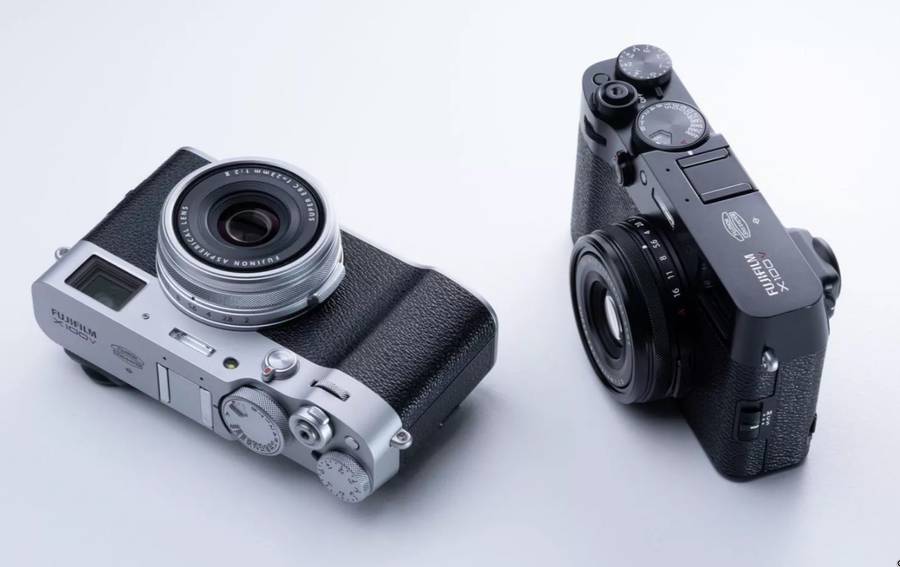Fujifilm has unveiled the X100V; the fifth in its series of X100 rangefinder-style cameras with improved features. So here is a Fujifilm X100V vs X100F vs X100T vs X100S vs X100 comparison that shows the highlights to help you for decision.
We are sure that only the X100F specs comparison will suffice for existing Fuji users. But we thought that for all users who are curious about Fuji’s latest premium digital compact camera, let’s put together the features of all the members of the series side by side.
The fifth-generation Fuji X100V now gains a new 26 megapixel APS-C BSI CMOS sensor and an updated fixed 23mm F2.0 lens. This sensor also offers a native base ISO of 160 up to ISO 12,800. Sensitivity can be expanded down to 100 and up to a maximum of 51,200.
At the core of the camera, the AF system has been revamped. The number of focusing points has been dramatically expanded from 49 in previous models to 91 (up to 425 points). Other key improvements offered by the X100V include a new tilting rear touchscreen LCD monitor, updated Advanced Hybrid Viewfinder, weather-proofing, the latest generation X-Processor 4, and 10-bit, 4:2:2 4K video up to 30fps and 1080p up to 120fps.
Fujifilm X100V is available with a price tag of $1399, or $1799 CAD. Check availability at B&H Photo / Amazon / Adorama.
Specifications Comparison of Fujifilm X100V vs X100F vs X100T vs X100S vs X100 Cameras
Below is a comprehensive table, showing each iteration of the Fuji X100 cameras, along with their key specifications.
| Specification | Fuji X100 | Fuji X100S | Fuji X100T | Fuji X100F | Fuji X100V |
|---|---|---|---|---|---|
| Announcement Date | 02/08/2011 | 01/07/2013 | 09/10/2014 | 01/19/2017 | 02/04/2020 |
| Sensor Type | CMOS | X-Trans CMOS II | X-Trans CMOS II | X-Trans CMOS III | X-Trans BSI CMOS IV |
| Low Pass Filter | Yes | No | No | No | No |
| Sensor Resolution | 12.3 MP | 16.3 MP | 16.3 MP | 24.3 MP | 26.1 MP |
| Sensor Size | 23.6 x 15.6mm | 23.6 x 15.6mm | 23.6 x 15.6mm | 23.6 x 15.6mm | 23.5 x 15.6mm |
| Native ISO Range | ISO 200-6400 | ISO 200-6400 | ISO 200–6400 | ISO 200–12800 | ISO 160–12800 |
| Image Processor | EXR Processor I | EXR Processor II | EXR Processor II | X Processor Pro | X Processor 4 |
| Viewfinder | Hybrid Optical EVF | Hybrid Optical EVF | Advanced Hybrid Optical EVF + ERF | Advanced Hybrid Optical EVF + ERF | Advanced Hybrid Optical OLED EVF + ERF |
| Viewfinder Coverage | 90% | 90% | 92% | 92% | 95% |
| EVF Resolution | 1.44 M-dots | 2.36 M-dots | 2.36 M-dots | 2.36 M-dots | 3.69 M-dots |
| EVF Type | LCD | LCD | LCD | LCD | OLED |
| Phase Detection AF | No | Yes | Yes | Yes | Yes |
| Autofocus Points | 49 | 49 | 49 | 325 | 425 |
| Exposure Comp. | ±2EV | ±2EV | ±3EV | ±5EV | ±5EV |
| Face / Eye AF | No / No | No / No | Yes / No | Yes / Yes | Yes / Yes |
| Lens | 23mm f/2.0 | 23mm f/2.0 | 23mm f/2.0 | 23mm f/2.0 | 23mm f/2.0 |
| Lens Elmnts / Groups | 8 / 6 | 8 / 6 | 8 / 6 | 8 / 6 | 8 / 6 |
| Aspherical Elements | 1 | 1 | 1 | 1 | 2 |
| Image Stabilization | No | No | No | No | No |
| Integrated ND Filter | Yes | Yes | Yes | Yes | Yes |
| Min Mechanical SS (A) | 30 sec | 30 sec | 30 sec | 30 sec | 30 sec |
| Max Mechanical SS | 1/4000 at f/8-16, 1/2000 at f/4-5.6, 1/1000 at f/2-2.8 | 1/4000 at f/8-16, 1/2000 at f/4-5.6, 1/1000 at f/2-2.8 | 1/4000 at f/8-16, 1/2000 at f/4-5/6, 1/1000 at f/2-2.8 | 1/4000 sec | 1/4000 sec |
| Max Electronic SS | N/A | N/A | 1/32000 | 1/32000 | 1/32000 |
| Flash Hotshoe | Yes | Yes | Yes | Yes | Yes |
| Built-in Flash | Yes | Yes | Yes | Yes | Yes |
| Quick Menu Button | No | Yes | Yes | Yes | Yes |
| Joystick | No | No | No | Yes | Yes |
| Front Command Dial | No | No | No | Yes | Yes |
| Cont. Shoot. Spd (M) | 5 fps | 6 fps | 6 fps | 8 fps | 11 fps |
| Cont. Shoot. Spd (E) | N/A | N/A | N/A | N/A | 20 fps |
| Buffer Size @ Max fps | 10 JPEG | 31 JPEG | 25 JPEG | 60 JPEG / 25 RAW | 38 JPEG / 17 RAW |
| Memory Card Slot | SD UHS-I | SD UHS-I | SD UHS-I | SD UHS-I | SD UHS-I |
| LCD Screen | 2.8″ Fixed | 2.8″ Fixed | 3.0″ Fixed | 3.0″ Fixed | 3.0″ Tilting |
| LCD Touchscreen | No | No | No | No | Yes |
| LCD Resolution | 460 K-dots | 460 K-dots | 1.04 M-dots | 1.04 M-dots | 1.62 M-dots |
| Video Rec @ Max fps | 1080p @ 60 fps | 1080p @ 60 fps | 1080p @ 60 fps | 1080p @ 60 fps | 4K @ 30 fps |
| F-Log | No | No | No | No | Yes |
| Slow Motion Video | No | No | No | No | 1080p @ 120 fps |
| Film Simulations | PROVIA, Velvia, ASTIA | PROVIA, Velvia, ASTIA, Sepia | PROVIA, Velvia, ASTIA, Classic Chrome, PRO Neg.Hi/Std, B&W, B&W+Ye/R/G Filter, Sepia | PROVIA, Velvia, ASTIA, Classic Chrome, PRO Neg.Hi/Std, B&W, B&W+Ye/R/G Filter, Sepia, ACROS, ACROS+Ye/R/G Filter | PROVIA, Velvia, ASTIA, Classic Chrome, PRO Neg.Hi/Std, B&W, B&W+Ye/R/G Filter, Sepia, ACROS, ACROS+Ye/R/G Filter, ETERNA, Classic Neg |
| Built-in Intervalometer | No | No | Yes | Yes | Yes |
| Built-in WiFi | No | No | Yes | Yes | Yes |
| Built-in Bluetooth | No | No | No | No | Yes, 4.2 |
| Microphone Port | No | No | Yes | Yes | Yes |
| USB | 2.0 | 2.0 | 2.0, Charging | 2.0, Charging | 3.1, Charging |
| Battery | NP-95 | NP-95 | NP-95 | NP-W126S | NP-W126S |
| EVF / OVF Battery Life | N/A / 300 shots | N/A / 330 shots | N/A / 330 shots | 270 / 390 shots | 350 / 420 shots |
| Weight (+Batt & SD) | 445g | 445g | 440g | 469g | 478g |
| Size | 127x74x54mm | 127x74x54mm | 127x74x52mm | 127x75x52mm | 128×75x53mm |
| MSRP Price | $1,299 | $1,299 | $1,299 | $1,299 | $1,399 |
Sensor
The X100V inherits the same basic sensor and processor combination we see on the X-T3 and X-Pro3 interchangeable-lens cameras. So you get 26MP of resolution from a BSI-CMOS sensor with Fuji’s X-Trans color filter array. You also get a new lower native ISO value of 160, though the native maximum remains 12800.
Autofocus
The new sensor brings with it a new on-sensor phase detection autofocus system (also borrowed from the X-Pro3), which has 425 AF points that are spread across almost the entire frame (up from 325 points on the X100F). Tracking autofocus is responsive, performing similarly to Fujifilm’s interchangeable-lens flagship models.
23mm f/2 lens
At first glance, the 23mm F2 lens on the X100V looks identical to its predecessors’. It has, in fact, been completely redesigned to offer better performance when using wide-apertures close-up, as well as generally better corner performance.
Viewfinder
Fujifilm says that the viewfinder on the X100V is essentially the same as that on the X-Pro3. It’s still a hybrid optical-and-electronic unit, it’s bigger than the older viewfinder and now has an OLED panel. This means that the information overlay in the optical mode can be brighter for easier viewing in bright light, but also that when you use the viewfinder in electronic mode, you get much better contrast than with the older LCD panel.
Screen
The X100V’s rear screen is touch-sensitive and a tilting design. This allows for you to place your AF point with you finger, drag your finger on the screen to place the AF point when your eye is to the finder, and utilize Fujifilm’s swiping touch-functions, first seen on the X-E3.
Video
The X100V comes with the most complete video feature set you’ll find on any camera of its type. You get 4K/30p internal recording at up to 200Mbps, with an option for F-log recording which is 8-bit only. The camera comes with the Eterna film simulation profile.
Read more Fujifilm Rumors.
Also join the Fujifilm Camera Users Facebook Group to share your Fujifilm photography.

